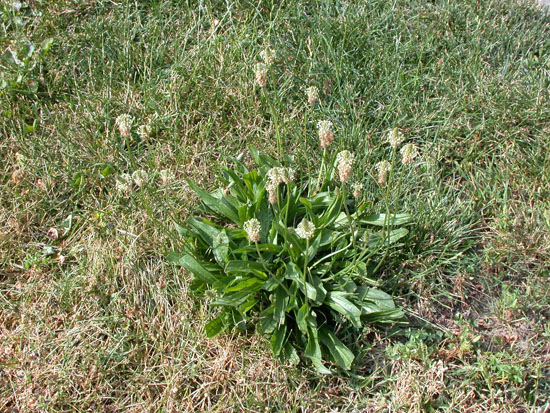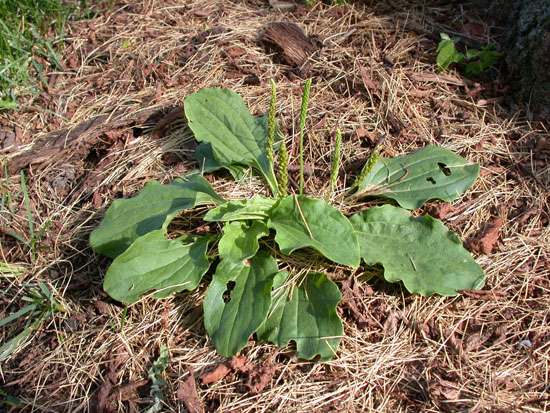Issue 9, June 18, 2012
The Rain (at my house) Falls Mainly on the Plantain
My yard is green. Sure it has its share of weeds but fortunately, they are green too. My nearest neighbor is ¼ mile away and we are both OK with the weeds in my yard--most of the time--as far as I know. A majority of my weeds belong to the plantain family (Plantaginaceae) which includes buckhorn plantain (Plantago lanceolata) and broadleaf plantain (P. major). For the most part, these rosette forming weeds are low lying and not noticeable to the 60 mph traffic whizzing past. They are however most noticeable when the seed heads develop and stand tall, therefore making the yard look ragged. The grass may not quite be tall enough to warrant being mowed, but you can bet my husband will drag the mower out just the same. Plantains have been cursed more than once at my house.
These cool-season perennials have a similar growth and tend to be found in meadows, pastures, waste areas, and lawns. Buckhorn plantain is common on drier sites, on neutral to basic soils, and in low-quality turf of low to moderate soil fertility. It can tolerate compacted soils and low mowing heights. Common buckthorn prefers fertile, moist soils but will tolerate some shade, low mowing, low fertility, compacted soils, and dry sites. I have found first hand that raising your mowing height can help shade out and kill the plantains.

Buckhorn Plantain in Flower (photo courtesy of Tom Voigt).
There are several differences between these similar species. The leaves of buckhorn plantain are lanceolate (much longer than they are wide), dark green, up to 1 ½ inches wide and 8 inches long. They are also sharp tipped, prominently parallel veined, and sometimes twisted and curled. The leaves of broadleaf plantain are broadly oval, hairy or smooth, and dark green. They can be up to 6 inches wide and 10 inches long. They are prominently parallel veined, and the margins are entire or wavy. The petioles can be reddish in color. A very similar species to broadleaf plantain is blackseed plantain (Rugel's plantain). I have never been able to look at a plant and differentiate between the two species. According to "Weeds of the Midwestern United States & Central Canada," the stems of blackseed plantain can be purple rather than dark red and the seed spike can be larger. To me, they look very similar. Maybe I'm more of a lumper than a splitter though.

Broadleaf plantain (photo courtesy of Tom Voigt).
Both plants can be found in flower summer-long well into the fall. Buckhorn plantain has many small whitish-tannish flowers that are tightly clustered at the end of a 6 to 30 inch long, hairy stalk. In contrast, broadleaf plantain produces numerous, inconspicuous flowers that are borne in dense clusters at the upper ends of 8 to 20 inch tall leafless, flowering stalks. These are similar in appearance to fingers or rat-tails. Both plants spread by seeds. Buckhorn plantain has a long sturdy taproot with lateral branches while broadleaf plantain has a short taproot with fibrous roots.
Plantains can be controlled without chemicals by simply maintaining turf density and health through proper culture. Fertilization practices should be evaluated. Mow as high as the use and appearance will allow to shade out weeds. These weeds can be hand-pulled or mechanically removed. Apply postemergence herbicides in mid spring to early summer and/or mid to late autumn when weeds are growing actively. Preemergence herbicides can be applied before seed germination. The herbicide 2,4-D has shown in the past to provide adequate control of plantains. Be sure to read and follow all label directions carefully in order to reduce the risk of off-target spray drift to sensitive ornamental plants.
My husband broke down and sprayed part of the lawn last summer. It went against our "as long as it's green, who cares" beliefs, but we have had fewer plantains this summer. A neighbor stated that he has seen more of it in his yard this year than in the past. New to our yard this year are rabbits. I've read that they love to eat plantain leaves. Maybe there is a correlation there. I'm not really sure which pest is worse. (Michelle Wiesbrook)
Author:
Michelle Wiesbrook